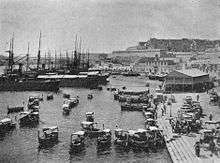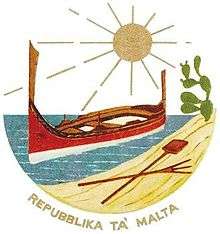Dgħajsa
A dgħajsa (Maltese pronunciation: [dɐɪsɐ], pl. dgħajjes [dɐɪjɛs])[1] is a traditional water taxi from Malta. The design of the dgħajsa, like that of another Maltese boat, the luzzu, possibly dates back to Phoenician times, although it was modified over time, especially during British rule in Malta.
Name
The word dgħajsa refers to any boat in the Maltese language, so they are also known as dgħajsa tal-pass to distinguish them from other boats. The boat is commonly referred to as Maltese Dgħajsa. In English, the word is sometimes pluralized "dgħajsas".
History

Dgħajjes were mainly used in the area of the Grand Harbour, to carry passengers (origin of pass in the name dgħajsa tal-pass) and small baggage from ships to shore. It was usually propelled by one man standing, facing forward, and pushing on two oars. The high stem and stern pieces seem to be mainly ornamental but they are useful in handling the boat and in the boarding and disembarking of passengers. The decorative symbols vary from boat to boat.[2]
A dgħajsa called St. Angelo which was built between 1950 and 1952 was commissioned by the Royal Navy and was used to ferry Princess Elizabeth from her ship to Fort St Angelo during one of her visits to Malta. This boat is still in use today and it was recently restored.[3] Until the 1970s, there were about a thousand registered dgħajjes in Malta.[4]
Dgħajjes are used daily as water taxis, from Birgu to Valletta. Today, only about 12 original dgħajjes survive, and they are used as a valuable means of transportation. Some of these have been motorized by diesel engines. The small number in existence is a result of the high maintenance costs and the fact that there are very few skilled carpenters who are capable of building these boats.[5] The Koperattiva tal-Barklori is a co-operative of boat owners who try to preserve the few remaining dgħajsas. The oldest one still in existence is the Palomba, which was built over 150 years ago and has been restored.[6]
A more modern version of the dgħajsa known as Dgħajsa tal-Midalji is used in the rowing regatta along with other traditional Maltese boats. The regatta is held on 31 March and 8 September of each year in the Grand Harbour.[7] Two Maltese dgħajjes competed in the Great River Race of 2012.[8][9]

The dgħajsa is one of the symbols of Malta and it appeared on the coat of arms of Malta from 1975 to 1988.
Cultural references
Cyril Tawney's song "The Ballad of Sammy's Bar" mentions these boats in which the last line of every verse is "Call away the di-so". Tawney appended the following note in explanation: "A dgħajsa is a Maltese gondola used by sailors for cutting across the creeks instead of going round them. In Malta they are a legal means of sailors getting back on board ship if they miss the liberty boat. In Britain it is illegal for them to use anything than the official liberty boats to get back to ship."[10]
See also
- Luzzu, sometimes mistakenly referred to as dgħajsa
References
| Wikimedia Commons has media related to Dgħajsa. |
- ↑ "Dizzjunarju tal-Malti - Maltese Dictionary". Dizzjunarju tal-Malti - Maltese Dictionary. Retrieved 2017-03-22.
- ↑ "Maltese Dghajsa named 'Wilson Pickett'". World of Boats. Retrieved 4 September 2014.
- ↑ "History". A & S Water Taxis. Retrieved 4 September 2014.
- ↑ Whibley, A. "Ancient & Scarce Water Taxis". A & S Water Taxis. Retrieved 4 September 2014.
- ↑ Castillo, Ruth (31 August 2014). "Baqa' biss madwar 12-il dgħajsa tal-pass". TVM. Retrieved 4 September 2014.
- ↑ "Oldest 'dgħajsa' to be used for commemoration of Manuel Dimech's exile". The Malta Independent. 1 September 2014. Retrieved 4 September 2014.
- ↑ Serracino, Joseph. "Boats used in Regatta". Sport in Malta. Retrieved 4 September 2014.
- ↑ Teed, Paul (26 August 2012). "Think you saw a flotilla at the jubilee? Just you wait". Richmond and Twickenham Times. Retrieved 4 September 2014.
- ↑ Partridge, Chris. "Dghajsas on the Thames". Rowing for Pleasure. Retrieved 4 September 2014.
- ↑ Modern Folk Ballads; selected by Charles Causley. London: Studio Vista, 1966; pp. 43-44